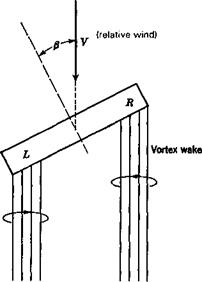Consider a vehicle constrained, as on bearings in a wind tunnel, to one degree of freedom-rolling about the x axis. The forces and moments resulting from a fixed displacement ф are fundamentally different in character from those associated with the rotations a and /3. In the first place if the x axis coincides with the velocity vector V, no aerodynamic change whatsoever follows from the fixed rotation ф (see Fig. 3.14). The aerodynamic field remains symmetrical with respect to the plane of symmetry, the resultant aerodynamic force remains in that plane, and no changes occur in any of the aerodynamic coefficients. Thus the roll stiffness ЭС/Эф = С, ф is zero in that case.
If the jc axis does not coincide with V, then a second-order roll stiffness results through the medium of the derivative ЭС/Э/3 = Clp. Let the angle of attack of the x axis be ax (see Fig. 1.7), then the velocity vector when ф — 0 is

 V cos ax 0
V cos ax 0
_ V sin ax _
After rolling through angle ф about Ox, the x component of the velocity vector remains unchanged, but the component V sin ax has projections on both of the new у

and г axes. Thus there is now a sideslip, and hence, an angle /3 and a resulting rolling moment. Using the notation of Appendix A.4, we get for the velocity vector in the new reference frame after the rotation ф
Thus the sideslip component is v = V sin ax sin ф, and the sideslip angle is
As a result of this positive /3, and the usually negative Ct there is a restoring rolling moment that is,
ДCf = Ct sin-1 (sin ax sin ф) (a)
For small ax, we get the approximate result
ДС, = Clf} sin-1 (ax sin ф) = Clfptx sin ф (b) (3.11,4)
and if ф also is small,

 ACt = С1рахФ
ACt = С1рахФ
The stiffness derivative for rolling about Ox is then from (3.11,4a)

 sin ax cos ф
sin ax cos ф
1/2 or for ax < 1,

![Roll Stiffness Подпись: or for cex, Ф <5 ]](/img/3129/image228_1.gif)
Э c,
1ф * c"“-
Thus there is a roll stiffness that resists rolling if ax is >0, and would tend to keep the wings level. If rolling occurs about the wind vector, the stiffness is zero and the vehicle has no preferred roll angle. If ax < 0, then the stiffness is negative and the vehicle would roll to the position ф = 180°, at which point C, == 0 and С1ф < 0.
The above discussion applies to a vehicle constrained, as stated, to one degree of freedom. It does not, by any means, give the full answer for an unconstrained airplane to the question: “What happens when the airplane rolls away from a wings – level attitude—does it tend to come back or not?” That answer can only be provided by a full dynamic analysis like the kind given in Chaps. 6 and 7. The roll stiffness argument given above, however, does help in understanding the behavior of slender airplanes, ones with very low aspect ratio and hence small roll inertia. These tend, in response to aileron deflection when at angle of attack, to rotate about the x axis, not the velocity vector, and hence experience the roll stiffness effect at the beginning of the response.
Even though airplanes have no first-order aerodynamic roll stiffness, stable airplanes do have an inherent tendency to fly with wings level. They do so because of what is known as the dihedral effect. This is a complex pattern involving gravity and the derivative C, , which owes its existence largely to the wing dihedral (see Sec. 3.12). When rolled to an angle ф, there is a weight component mg sin ф in the у direction (Fig. 3.14). This induces a sideslip velocity to the right, with consequent (3 > 0, and a rolling moment C, /3 that tends to bring the wings level. The rolling and yawing motions that result from such an initial condition are, however, strongly coupled, so no significant conclusions can be drawn about the behavior except by a dynamic analysis (see Chap. 6).


![]()



















